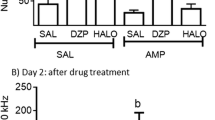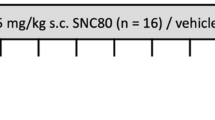Abstract
Weanling rats were treated with diazepam, apomorphine, and haloperidol to study the influence of the dopamine (DA) system on the audiogenic immobility reaction and open field locomotory behavior. Treatment with diazepam (0.025, 0.05, and 0.1 mg/kg) caused a dose-dependent shortening of the duration of the immobility response. Treatment with apomorphine (0.125, 0.25, and 0.50 mg/kg) shortened both the immobility reaction and the latency to leave the spot where the animal was first placed in the open field (latency for first crossing). Locomotor activity increased in a dose-dependent fashion. Both grooming and rearing showed biphasic dose response curves, with a maximum occurring at the 0.125 mg/dose for grooming and at the 0.25 mg/dose for rearing. Haloperidol (0.06 mg/kg) exerted opposite effects to those of apomorphine, but also produced increased running during the auditory stimulation (flight distance). Using the immobility reaction as an expression of fear, we concluded that activation of the DA system decreases while inhibition of the DA system increases fear. It was hypothesized that the DA system exerts an inhibitory function in the expression of fear.
Similar content being viewed by others
References
Archer J (1973) Test for emotionality in rats and mice: A review. Anim Behav 21:205–235
Archer J (1976) The organization of agression and fear in vertebrates. In: Bateson PPG, Klopfer PH (eds) Perspectives in ethology, vol 2. Plenum Press, New York. pp 231–298
Bindra D, Spinner N (1958) Response to different degrees of novelty: the incidence of various activities. J Exp Anal Behav 1:341–350
Bradley JW (1968) Distribution-free statistical tests. Prentice Hall, London
Colbern DL, Isaacson R, Bohus B, Gispen WH (1978) Repeated intraventricular injections of ACTH1–24. The effects of home or novel environments on excessive grooming. Behav Biol 23:381–387
Cook L, Sepinwall J (1975) Behavioral analysis of the effects and mechanisms of action of benzodiazepines. In: Costa E, Greengard P (eds) Mechanism of action of benzodiazepines. Raven Press, New York, pp 1–28
Cramér H (1946) Mathematical methods of statistics. Princeton University Press
Crawley JN, Moody TW (1983) Anxiolytics block excessive grooming behavior induced by ACTH1–24 and bombesin. Brain Res Bull 10:399–402
Davis M, Redmond DE Jr, Baraban JM (1979) Noradrenergic agonists and antagonists: Effects on conditioned fear as measured by the potentiated startle paradigm. Psychopharmacology 65:111–118
Dunn AJ, Green EH, Isaacson RL (1979) Intercerebral adrenocorticotropic hormone mediates novelty-induced grooming in the rat. Science 203:281–283
File SE, Hyde JRG (1977) The effects of p-chlorophenylalanine and ethanolamine-0-sulphate in an animal test of anxiety. J Pharm Pharmacol 29:735–738
File SE, Velucci SV (1978) Studies on the role of ACTH and of 5-HT in anxiety, using an animal model. J Pharm Pharmacol 30:105–110
Geller I, Blum K (1970) The effects of 5-HTP on para-chlorophenylalanine (p-CPA) attenuation of “conflict” behavior. Eur J Pharmacol 9:319–324
Gispen WH, Isaacson RL (1981) ACTH-induced excessive grooming in the rat. Pharmacol Ther 12:209–245
Gispen WH, Wiegant VM, Greven HM, de Wied D (1975) The induction of excessive grooming in the rat by intraventricular application of peptides derived from ACTH: structure-activity study. Life Sci 17:645–652
Hansen S, Hård E (1980) Ontogeny of the audiogenic immobility reaction in the rat. Biol Behav 5:163–168
Hård E, Ahlenius S, Engel J (1983) Effects of neonatal treatment with 5,7-dihydroxytryptamine or 6-hydroxydopamine on the ontogenetic development of the audiogenic immobility reaction in the rat. Psychopharmacology 80:269–274
Hyslop DJ, Becker JA, Eison MS, Riblet LA, Taylor DP (1982) Effects of buspiron, a novel anxioselective drug, on l-dopa levels. Abstr Biomed Applications LCEC Voltammetry, No. 68 (according to Taylor et al. 1982)
Janssen PA, van Beuer WFM (1978) Structure-activity relationships of the butyrophenones and diphenylbutylpiperidines. In: Iversen LL, Iversen SD, Snyder SH (eds) Handbook of psychopharmacology, vol 10. Plenum Press, New York, pp 1–35
Kameyama T, Nagasaka M (1982) Effects of apomorphine and diazepam on a quickly learned conditioned suppression in rats. Pharmacol Biochem Behav 17:59–63
Mantel N (1963) Chi-square tests with one degree of freedom: extension of the Mantel-Maenszel procedure. J Am Statist Assoc 58:680–700
Redmond DE Jr (1977) Alterations in the function of nucleus locus coeruleus: A possible model for studies of anxiety. In: Hanin I, Usdin E (eds) Animal models in psychiatry and neurology. Pergamon, New York, pp 293–304
Redmond DE Jr, Huang YH (1979) New evidence for a locus coeruleus-norepinephrine connection with anxiety. Life Sci 25:2149–2162
Stein L, Wise CD, Belluzzi JD (1975) Effects of benzodiazepines on central serotonergic mechanisms. In: Costa E, Greengard P (eds) Mechanism of action of benzodiazepines. Raven Press, New York, pp 29–44
Taylor DP, Riblet LA, Stanton HC, Eison AS, Eison MS, Temple DL Jr (1982) Dopamine and antianxiety activity. Pharmacol Biochem Behav (Suppl 1) 17:25–35
Tye NC, Everitt BJ, Iversen SD (1977) 5-Hydroxytryptamine and punishment. Nature 268:741–743
Tye NC, Iversen SD, Green AR (1979) The effects of benzodiazepines and serotonergic manipulations on punished responding. Neuropharmacology 18:689–695
Vogel JR, Beer B, Clody DE (1971) A simple and reliable conflict procedure for testing antianxiety agents. Psychopharmacologia 21:1–7
Author information
Authors and Affiliations
Rights and permissions
About this article
Cite this article
Hård, E., Engel, J., Larsson, K. et al. Effect of Diazepam, Apomorphine and Haloperidol on the audiogenic immobility reaction and on the open field behavior. Psychopharmacology 85, 106–110 (1985). https://doi.org/10.1007/BF00427332
Received:
Accepted:
Issue Date:
DOI: https://doi.org/10.1007/BF00427332




